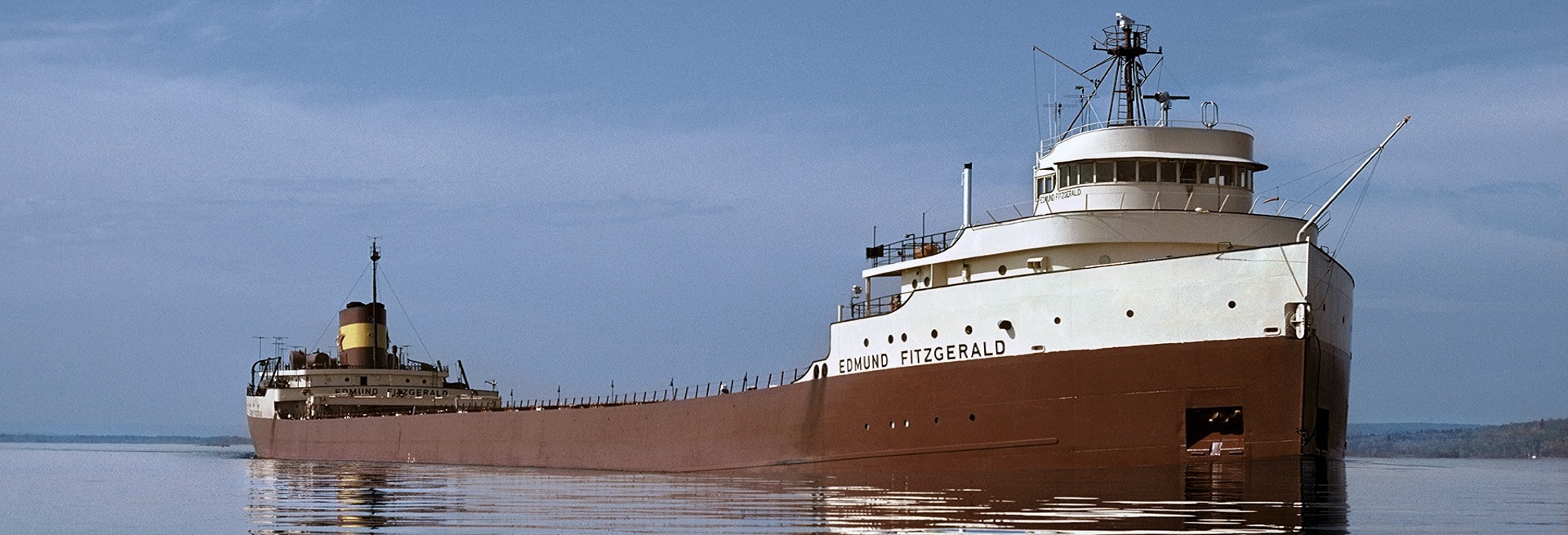
Edmund Fitzgerald
St. Marys River, 1975. Photo by Bob Campbell
The Edmund Fitzgerald
The legend of the Edmund Fitzgerald remains the most mysterious and controversial of all shipwreck tales heard around the Great Lakes. Her story is surpassed in books, film and media only by that of the Titanic. Canadian folksinger Gordon Lightfoot inspired popular interest in this vessel with his 1976 ballad, “The Wreck of the Edmund Fitzgerald.”
The Edmund Fitzgerald was lost with her entire crew of 29 men on Lake Superior November 10, 1975, 17 miles north-northwest of Whitefish Point, Michigan. Whitefish Point is the site of the Whitefish Point Light Station and Great Lakes Shipwreck Museum. The Great Lakes Shipwreck Historical Society (GLSHS) has conducted three underwater expeditions to the wreck, 1989, 1994, and 1995.


Fitzgerald’s Bell
Fitzgerald’s 200 lb. bronze bell was recovered on July 4, 1995. This expedition was conducted jointly with the Great Lakes Shipwreck Historical Society, National Geographic Society, Canadian Navy, Sony Corporation, and Sault Ste. Marie Tribe of Chippewa Indians. The bell is now on display in the Great Lakes Shipwreck Museum at Whitefish Point as a memorial to her lost crew.
Shipwreck Museum’s Edmund Fitzgerald Memorial Event
The Great Lakes Shipwreck Museum’s annual Edmund Fitzgerald memorial event will be offered as a livestream ceremony in 2024. The event is closed to the public, but will be available on a livestream link that you can watch from your device of choice. The buildings of the Great Lakes Shipwreck Museum at Whitefish Point, are not open to the public on November 10, 2024.
About the Ship
The S.S. Edmund Fitzgerald was conceived as a business enterprise of the Northwestern Mutual Life Insurance Company of Milwaukee, Wisconsin. Northwestern Mutual contracted with Great Lakes Engineering Works of Ecorse, Michigan to construct a “maximum sized” Great Lakes bulk carrier. Her keel was laid on August 7, 1957 as Hull No. 301.
Named after the President and Chairman of the Board of Northwestern Mutual, Fitzgerald was launched June 8, 1958 at River Rouge, Michigan. Northwestern Mutual placed her under permanent charter to the Columbia Transportation Division of Oglebay Norton Company, Cleveland, Ohio. At 729 feet and 13,632 gross tons she was the largest ship on the Great Lakes, for thirteen years, until 1971.
The Fitzgerald’s normal course during her productive life took her between Silver Bay, Minnesota, where she loaded taconite, to steel mills on the lower lakes in the Detroit and Toledo area. She was usually empty on her return trip to Silver Bay. On November 9, 1975 Fitzgerald was to transport a load of taconite from Superior, Wisconsin, to Zug Island, Detroit, Michigan.
Learn some of the “odd” things that happened during the launch of the Fitzgerald in 1958 in this short story!

Launch Date - June 8, 1958
The Night the Fitzgerald Went Down
Through the Eyes of Captain Cooper: This is the last interview conducted of Capt. Bernie Cooper of the Arthur M. Anderson before he passed in 1993. The Anderson was 10 miles behind the Fitzgerald that fateful night.
The Lost Fitzgerald Search Tapes
Rare radio chatter between the Arthur M. Anderson and the Coast Guard November 10th, 1975.
This is the last time anyone ever heard from the Edmund Fitzgerald.
The Fateful Journey
The final voyage of the Edmund Fitzgerald began November 9, 1975 at the Burlington Northern Railroad Dock No.1, Superior, Wisconsin. Captain Ernest M. McSorley had loaded her with 26,116 long tons of taconite pellets, made of processed iron ore, heated and rolled into marble-size balls. Departing Superior about 2:30 pm, she was soon joined by the Arthur M. Anderson, which had departed Two Harbors, Minnesota under Captain Bernie Cooper. The two ships were in radio contact. The Fitzgerald being the faster took the lead, with the distance between the vessels ranging from 10 to 15 miles.
Aware of a building November storm entering the Great Lakes from the great plains, Captain McSorley and Captain Cooper agreed to take the northerly course across Lake Superior, where they would be protected by highlands on the Canadian shore. This took them between Isle Royale and the Keweenaw Peninsula. They would later make a turn to the southeast to eventually reach the shelter of Whitefish Point.
Weather conditions continued to deteriorate. Gale warnings had been issued at 7 pm on November 9, upgraded to storm warnings early in the morning of November 10. While conditions were bad, with winds gusting to 50 knots and seas 12 to 16 feet…




